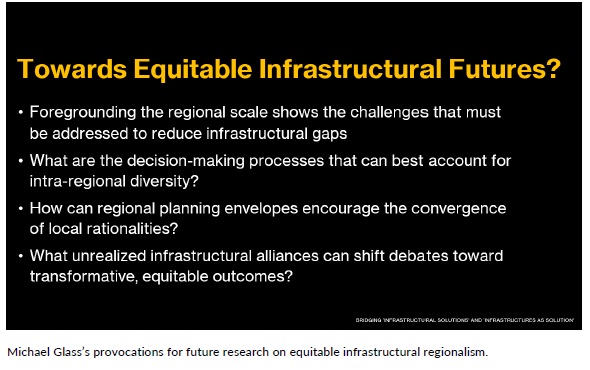RSA Events – Event Report – Infrastructuring Regions by RSA Research Network on Infrastructural Regionalism (NOIR)
The 2025 Annual Meeting of the American Association of Geographers in Detroit (on infrastructuring regions) by Regional Studies Association Research Network on Infrastructural Regionalism (NOIR)
By Dr. Jean-Paul Addie (email), Urban Studies Institute, Georgia State University (USA), Dr. Michael Glass (email), Urban Studies Program, University of Pittsburgh (USA) and Dr. Jen Nelles (email), Oxford Brookes University Business School (UK)
About NOIR
The RSA Research Network on Infrastructural Regionalisms (NOIR) challenges regional studies to address infrastructural questions by critically unpacking how infrastructure shapes regional lives, governance, and developmental pathways. Our conceptual framing of ‘infrastructural regionalism’ focuses on those infrastructures that have relevance beyond the local. Analysing regions through infrastructure provides a novel perspective on the regional question, as investment and disinvestment in infrastructure reveal vital discursive and material elements that produce, structure, and modify metropolitan regions worldwide. The development of infrastructural assets – ranging from transport and telecommunications to energy and sanitation – as part of regional policies raises conceptual and applied questions about how the funding, governance, and spatiality of such infrastructure can promote urban, economic, and ecological sustainability at the regional scale.
NOIR’s Aims:
- Showcase theoretically informed, empirically grounded research at the intersection of infrastructure studies and regional studies.
- Promote the formation of collaborative, interdisciplinary, and comparative research teams to stake out and mobilize new research agendas at the intersection of infrastructure and the region.
- Foster novel scholarship through senior/junior scholar and academic/practitioner exchanges at RSA network events.
- Promote information exchanges that can inform regional development policies.
Report
Infrastructuring Regions
The events consisted of three sessions on the ‘Infrastrucuring Regions’ theme organized at the Annual Meeting of the American Association of Geographers. Taking inspiration from the AAG Meeting’s setting in Detroit, NOIR organized a series of paper panels exploring infrastructure’s role in co-constituting regional territories, corridors, and networks across borders. In thinking regionally about infrastructure—an approach the network theorizes as ‘infrastructural regionalism’—presenters addressed how infrastructure is governed across or constrained by jurisdictional boundaries, whether at intra-metropolitan, subnational, or international scales.
This included asking who drives the construction of regional infrastructural imaginaries, examining the funding, decision-making, and institutional apparatus governing the movement of people and goods at various scales, and engaging how key actors, institutions, and communities understand and experience the infrastructuring of regional space. In sum, NOIR’s AAG sessions intended to foster a robust and engaging exploration of regional infrastructuring, engaging questions regarding the impacts of infrastructure development on economic, social, and environmental sustainability in cross-border regions, the policy frameworks and governance structures that facilitate or hinder cross-border infrastructural projects, and the capacity of a variety of infrastructures to enhance cross-border mobility and regional integration.
Approximately 35 people in person attended the special sessions and the NOIR keynote across the sessions (speakers and session attendees). Presenters came from 7 countries: the United Kingdom, the United States, Canada, Italy, Belgium, Taiwan, and Singapore.
Session 1: The State of Infrastructural Regions
• Dylan Brady, National University of Singapore, “Southeast Asia’s digital payment landscape: State engagement and non-symmetrical networks”
• Yimeng Yang, Northeastern University, “State assetization of waste: a new frontier for infrastructure financing experiments in China’s city-regional development”
• I-Chun Catherine Chang Macalester College (presenting on behalf of her co-authors Sue-Ching Jou (National Taiwan University) and Ming-Kuang Chung (Academia Sinica) “Smart-state Restructuring: the Re territorialization of Taipei Smart-city Developments”
• Ryan Centner, London School of Economics, “In the air, on the ground, over the sea, through an empire: Aviation infrastructure and territorial affect across Micronesia”
Session 2: Borders, Corridors, and Networks
• Alberto Valz Gris, Politecnico di Torino, “Corridor in the making: Contested imaginaries of infrastructural urbanization across the port of Genoa and its extensions”
• Pilar Delpino Marimon, Clark University, “Unbuilt infrastructures and their effects in the Peruvian- Brazilian borderland” (presenting remotely)
• Wojciech Keblowski, Vrije Universiteit Brussel, “Localising global infrastructure at the “gateway to Europe”: the second life of transhipment ports at the Poland-Belarus border”
Session 3: Reimaging Regional Infrastructure
• Michael Glass, University of Pittsburgh (and Jean-Paul Addie, Georgia State University), “Bridging ‘Infrastructural Solutions’ and ‘Infrastructures as Solution’: Regional Promises and Urban Pragmatism”
• Katherin Rankin, University of Toronto and Dinesh Paudel, Appalachian State University, “A Himalayan conjuncture for infrastructural regionalism?”
• John Stehlin, University of North Carolina – Greensboro, “Transborder Infrastructures, Local Burdens: Interscalar Interdependencies and the Shaping of Urban Highway Mitigation in Madrid and Bilbao”
• Keith Harris, University of Washington, “From transportation infrastructure to éco-tiers-lieux.
The papers were selected from a pool of submissions to the open call given their focus on, and engagement with, questions of regional infrastructure and infrastructural regionalism. We paid particular attention to issues of disciplinary and topic diversity and looked to include presentations from early career researchers.

Conclusions
Across three well-attended panels, this event provided a rich exploration of how infrastructure shapes regional development and governance across diverse global contexts. A key theme that emerged was the central role of state influence in infrastructure development, whether through digital payment systems in Southeast Asia or waste-to-energy projects in China. In Malaysia, digital payment platforms such as DuitNow and Touch’nGo illustrate strong state involvement in expanding financial networks beyond national borders. Similarly, China’s approach to waste management has increasingly relied on financial instruments to fund infrastructure, though often at the expense of socio-ecological goals. These examples underscore how governments leverage infrastructure to drive economic and technological integration, reinforcing their regulatory power while navigating complex trade-offs.
Another critical topic was the governance tensions inherent in smart city development, particularly in Taipei, where urban technology policies reshape territorial relationships. Implementing smart city strategies has ignited stakeholder conflicts, including national and local governments, private entities, and civic groups. While the central government envisions smart cities as a national strategy, Taipei utilizes them for political autonomy, highlighting mismatched interests between different actors. These struggles over funding, regulation, and data management illustrate the intricate politics of infrastructural transformation, where competing agendas drive reterritorialization processes and shape governance frameworks.
Infrastructure functions as a tool for regional connectivity, whether through built or unbuilt corridors. In the Amazon, for example, the stalled Pucallpa-Cruzeiro do Sul transboundary project demonstrates how even unbuilt infrastructure can significantly influence governance and territorial speculation. Such projects do not merely exist in physical form but also serve as powerful symbolic artifacts that shape policy, land use, and transnational relationships. Similarly, transhipment hubs along the Poland-Belarus border expose how historical trade patterns intersect with contemporary geopolitical strategies. These ports, once tied to Soviet-era commerce, now play a pivotal role in the Belt and Road Initiative, reflecting a layered relationship between imagined prosperity, structural inequalities, and infrastructural transformation.
Retrofitting existing infrastructure emerged as a promising yet complex strategy for future development. Whether through regional transportation planning in the United States or highway removal efforts in Spain, these projects seek to reconcile environmental sustainability with economic and logistical necessities. In the U.S., fragmented decision-making has impeded cohesive regional planning, complicating efforts to integrate equitable urban development solutions. Meanwhile, Spain’s attempts to modify Franco-era highways reveal contradictions between urban quality-of-life improvements and the enduring demands of transport infrastructure. These cases demonstrate that infrastructural change is often fraught with competing priorities, requiring careful negotiation between localized concerns and broader mobility needs.
Presentations also highlighted emerging regionalisms in infrastructure planning in various geographic and temporal contexts. For example, as Nepal responds to seismic and political transformations, its approach to infrastructure has evolved from social empowerment strategies to a more calculated engagement with regional development, strategically repositioning the country within shifting geopolitical frameworks. Competing infrastructural influences from China, India, and the India-Middle East-Europe Economic Corridor illustrate how smaller states navigate global power dynamics, leveraging infrastructure investments to assert agency in an increasingly multipolar world.
Finally, infrastructure can serve as cultural and ecological spaces, transcending its traditional function as a transportation and economic activity conduit. In Paris and Île-de-France, transportation infrastructure is reimagined as third places that foster cultural engagement and sustainability. By integrating ecological principles into municipal governance, these evolving spaces reflect a growing emphasis on bioclimatic urbanism and nonprofit-driven initiatives. This shift signals a broader reconsideration of infrastructure’s role in shaping urban experiences, demonstrating how transport networks can become vital hubs for environmental consciousness and community interaction.
This event illuminated the deep interconnections between infrastructure, governance, and global economic systems. It showcased the infrastructure’s transformative potential while revealing the tensions embedded in its development and management. The discussions underscored how infrastructure is not merely physical but deeply entwined with political, economic, and social narratives, profoundly shaping regional and global landscapes.

Jean-Paul Addie, Michael Glass and Jen Nelles



